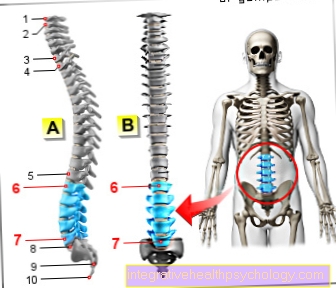Exercises against positional dizziness
introduction
At the benign paroxysmal Positional vertigo it is a very common form of dizziness, which occurs particularly with jerky turning movements. Cause are small crystalsthat get stuck in the human ear canals, and so the flow of those there Endolymph disturb and lead to discomfort. We perceive these abnormal sensations as dizziness.
More about this topic can be found Dizziness from the inner ear

Exercises
There are several very simple exercises to use high success ratewith which the very unpleasant dizziness can be treated efficiently and quickly. Your family doctor or neurologist has probably already informed you about one of these exercises. However, since these must be carried out according to a precisely specified pattern in order to be successful, they are described again in detail here. The two best known are the so-called “Liberation maneuvers” according to Epley and Semont. It should be noted that sudden nausea can occur with these exercises, so appropriate precautions should be taken.
More about this topic can be found Vertigo therapy
Epley maneuver
The patient sits upright on the bed. Now he turns his head 45 degreesso that the examiner standing in front of him looks at the healthy ear. For the sake of clarity, it is assumed in these and the following examples that the affected ear is the right ear. The patient would now look to the right so that the left, healthy ear points towards the examiner. Now the patient lies flat on his back and lets his head hang back over the couch or, if you are at home, over the couch, slightly overstretched. The patient now remains in this position, always with the head turned to the "sick" side, until the vertigo and trembling eyes have disappeared.
Now the head is rotated 90 degrees from its 45 degree right position to a 45 degree left position. You will again wait at least a minute for the vertigo to subside. Now the entire body follows the head, so that the patient lies on the left side on the bed or couch. The head is turned a little further towards the ground. The patient must remain in this position for another minute.
When the dizziness and trembling eyes have subsided, the patient sits down abruptly as if he were sitting "normally" on the couch. Maybe it can severe nausea so your eyes should be closed on this last step. The Epley maneuver is now complete and the dizziness should have subsided. If this maneuver did not lead to success, it still can two to three times be repeated. If the symptoms do not improve, the cause may be different or the exercise may not be suitable.
Further information on this topic can be found at Positional vertigo self-treatment
Semont maneuver
The patient sits upright on a couch or bed and looks in the direction of the examiner. Now the patient turns his head 45 degrees on the healthy side so that the affected side faces the examiner. The examiner now moves the patient very fast in the sideways position, in such a way that the patient is looking up and the back of his head is on the bed. The patient remains in this position for 2-3 minutes.
Now he's going abruptly around 180 degrees turned to the other side of the bed so that the head is now on the foot side of the bed and the face points towards the bed. It is important to ensure that the patient's head is not turned.
Lastly, the patient will be back slowly brought back to the sitting position and left there for 2-3 minutes. The positional vertigo should now be gone.
With a little practice, the maneuver can also be carried out alone, as it is relatively straightforward. Instead of a lounger, a couch or bed is best for this. The maneuver can be performed two to three times. Further repetitions do not promise an increased likelihood of improvement.
More about this topic can be found Positional vertigo self-treatment
Brandt-Daroff maneuvers
The Brandt-Daroff maneuver, while easy to perform, is often less effective than the other two techniques. The patient sits sideways on a couch and looks straight at the practitioner. Now he turns his head 45 degrees to the healthy side, then he tips over quickly on the vertigo affected side. It is now waited until the dizziness that has occurred subsides again.
Then again in the Starting position returned, which can lead to dizziness again. Only when this has subsided is continued. The maneuver is now mirrored executed to the other side. In this position, wait until any dizziness that has occurred has subsided. Once this has happened, the Starting position taken. This ends the exercise.
This maneuver can also be repeated several times a day.
How often should the exercises be done?
Many patients wonder how often they should do the exercises described. It should be said that, as a rule, a Almost 100% chance of success entry. A repetition is only necessary in individual cases. So if, provided that it is done correctly, the vertigo persists even after the second and third attempts, so a neurologist should be consultedas another cause of the positional vertigo must also be considered. As is so often the case, the old saying “a lot helps a lot” does not necessarily apply in this case either. It doesn't matter how often the exercise was done, but more that it was done was performed correctly once.
A prophylactic execution of the exercises makes no sense insofar as there are no crystals in the auditory canals when you are free from giddiness that you would have to move. There is much more the risk that unnecessarily fast movements will trigger vertigo. So a liberation maneuver should only in acute cases be performed. If the dizziness has already occurred, it can be due to incorrect or incomplete performance of the exercises no additional damage arise. The only result of doing this incorrectly is that the dizziness persists and the nausea provoked during the exercise was more or less “for nothing”. Apart from that, however, there is no anatomical damage.
Read our general article on this Vertigo training.
What to do if these exercises don't help
If the diagnosis of positional vertigo has been confirmed by a doctor, the liberation maneuvers are currently the only treatment option, albeit one Success rate of almost 100% exhibit. In very severe cases, a surgery be necessary, which is, however, very complicated and risky. A medical therapy does not exist at the moment (as of 2016). It is extremely unlikely that the positional dizziness will not go away if the above exercises are performed correctly.
If this is the case, further diagnostics may have to be carried out in order to rule out the possibility of a misdiagnosis. In any case, this should be done by a neurologist, including imaging tests. In order to perform the exercises correctly, it is advisable to have a partner at your side to support you, at least for the first few exercises.





























